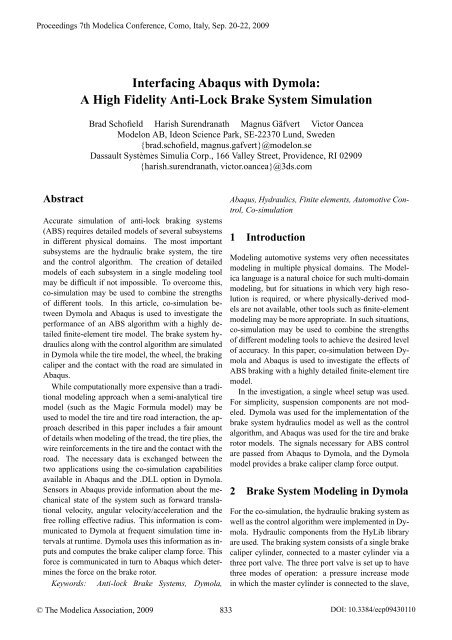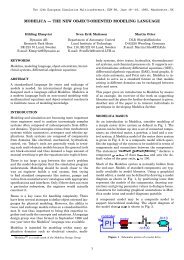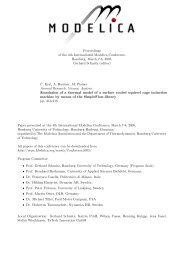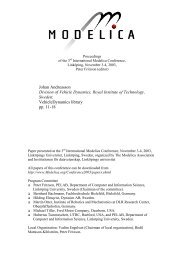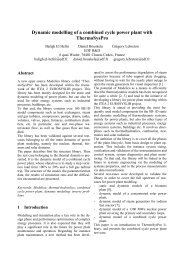Interfacing Abaqus with Dymola: A High Fidelity Anti-Lock ... - Modelica
Interfacing Abaqus with Dymola: A High Fidelity Anti-Lock ... - Modelica
Interfacing Abaqus with Dymola: A High Fidelity Anti-Lock ... - Modelica
Create successful ePaper yourself
Turn your PDF publications into a flip-book with our unique Google optimized e-Paper software.
Proceedings 7th <strong>Modelica</strong> Conference, Como, Italy, Sep. 20-22, 2009<br />
Abstract<br />
<strong>Interfacing</strong> <strong>Abaqus</strong> <strong>with</strong> <strong>Dymola</strong>:<br />
A <strong>High</strong> <strong>Fidelity</strong> <strong>Anti</strong>-<strong>Lock</strong> Brake System Simulation<br />
Brad Schofield Harish Surendranath Magnus Gäfvert Victor Oancea<br />
Modelon AB, Ideon Science Park, SE-22370 Lund, Sweden<br />
{brad.schofield, magnus.gafvert}@modelon.se<br />
Dassault Systèmes Simulia Corp., 166 Valley Street, Providence, RI 02909<br />
{harish.surendranath, victor.oancea}@3ds.com<br />
Accurate simulation of anti-lock braking systems<br />
(ABS) requires detailed models of several subsystems<br />
in different physical domains. The most important<br />
subsystems are the hydraulic brake system, the tire<br />
and the control algorithm. The creation of detailed<br />
models of each subsystem in a single modeling tool<br />
may be difficult if not impossible. To overcome this,<br />
co-simulation may be used to combine the strengths<br />
of different tools. In this article, co-simulation between<br />
<strong>Dymola</strong> and <strong>Abaqus</strong> is used to investigate the<br />
performance of an ABS algorithm <strong>with</strong> a highly detailed<br />
finite-element tire model. The brake system hydraulics<br />
along <strong>with</strong> the control algorithm are simulated<br />
in <strong>Dymola</strong> while the tire model, the wheel, the braking<br />
caliper and the contact <strong>with</strong> the road are simulated in<br />
<strong>Abaqus</strong>.<br />
While computationally more expensive than a traditional<br />
modeling approach when a semi-analytical tire<br />
model (such as the Magic Formula model) may be<br />
used to model the tire and tire road interaction, the approach<br />
described in this paper includes a fair amount<br />
of details when modeling of the tread, the tire plies, the<br />
wire reinforcements in the tire and the contact <strong>with</strong> the<br />
road. The necessary data is exchanged between the<br />
two applications using the co-simulation capabilities<br />
available in <strong>Abaqus</strong> and the .DLL option in <strong>Dymola</strong>.<br />
Sensors in <strong>Abaqus</strong> provide information about the mechanical<br />
state of the system such as forward translational<br />
velocity, angular velocity/acceleration and the<br />
free rolling effective radius. This information is communicated<br />
to <strong>Dymola</strong> at frequent simulation time intervals<br />
at runtime. <strong>Dymola</strong> uses this information as inputs<br />
and computes the brake caliper clamp force. This<br />
force is communicated in turn to <strong>Abaqus</strong> which determines<br />
the force on the brake rotor.<br />
Keywords: <strong>Anti</strong>-lock Brake Systems, <strong>Dymola</strong>,<br />
<strong>Abaqus</strong>, Hydraulics, Finite elements, Automotive Control,<br />
Co-simulation<br />
1 Introduction<br />
Modeling automotive systems very often necessitates<br />
modeling in multiple physical domains. The <strong>Modelica</strong><br />
language is a natural choice for such multi-domain<br />
modeling, but for situations in which very high resolution<br />
is required, or where physically-derived models<br />
are not available, other tools such as finite-element<br />
modeling may be more appropriate. In such situations,<br />
co-simulation may be used to combine the strengths<br />
of different modeling tools to achieve the desired level<br />
of accuracy. In this paper, co-simulation between <strong>Dymola</strong><br />
and <strong>Abaqus</strong> is used to investigate the effects of<br />
ABS braking <strong>with</strong> a highly detailed finite-element tire<br />
model.<br />
In the investigation, a single wheel setup was used.<br />
For simplicity, suspension components are not modeled.<br />
<strong>Dymola</strong> was used for the implementation of the<br />
brake system hydraulics model as well as the control<br />
algorithm, and <strong>Abaqus</strong> was used for the tire and brake<br />
rotor models. The signals necessary for ABS control<br />
are passed from <strong>Abaqus</strong> to <strong>Dymola</strong>, and the <strong>Dymola</strong><br />
model provides a brake caliper clamp force output.<br />
2 Brake System Modeling in <strong>Dymola</strong><br />
For the co-simulation, the hydraulic braking system as<br />
well as the control algorithm were implemented in <strong>Dymola</strong>.<br />
Hydraulic components from the HyLib library<br />
are used. The braking system consists of a single brake<br />
caliper cylinder, connected to a master cylinder via a<br />
three port valve. The three port valve is set up to have<br />
three modes of operation: a pressure increase mode<br />
in which the master cylinder is connected to the slave,<br />
© The <strong>Modelica</strong> Association, 2009 833 DOI: 10.3384/ecp09430110
Proceedings 7th <strong>Modelica</strong> Conference, Como, Italy, Sep. 20-22, 2009<br />
a hold mode in which all ports are disconnected, and<br />
a pressure decrease mode in which the slave cylinder<br />
is connected to a tank. A return circuit is not modeled.<br />
This system represents the simplest form of production<br />
ABS implementation in which brake fluid is<br />
not returned to the master cylinder during braking, but<br />
rather after the braking event has taken place.<br />
Figure 1: Diagram view of the brake system hydraulics<br />
and control model in <strong>Dymola</strong><br />
2.1 Control Algorithm<br />
Control is performed by modulating the position of the<br />
three port valve depending on wheel acceleration and<br />
slip. The algorithm is based on that described in the<br />
Bosch Automotive Handbook [1], and is modeled as<br />
a state machine. The required inputs to the controller<br />
are wheel angular velocity ω, angular acceleration ˙ω,<br />
rolling radius r and hub longitudinal velocity vx. The<br />
input signals to the controller are sampled <strong>with</strong> period<br />
Ts = 1ms. The longitudinal slip is calculated as<br />
λ = vx − rω<br />
vx<br />
The ABS is triggered when the wheel deceleration<br />
falls below the prescribed threshold −a. Pressure<br />
is then held until the slip exceeds a threshold λT ,<br />
at which point pressure is dropped for a given time.<br />
Pressure is the held until a positive acceleration A is<br />
reached, at which point pressure is increased until the<br />
acceleration drops to a. At this point pressure is increased<br />
slowly via alternate hold and increase commands.<br />
This allows the ‘peak’ of the friction characteristic<br />
to be traversed slowly, before the unstable side is<br />
© The <strong>Modelica</strong> Association, 2009 834<br />
reached. The cycle begins again once the −a acceleration<br />
threshold is crossed. The controller is deactivated<br />
for longitudinal velocities under a prescribed level. In<br />
addition, a timeout parameter is used to reset the ABS<br />
algorithm if it remains in any one state for extended<br />
periods. This is necessary to prevent the controller becoming<br />
‘locked’ in any state when ABS action is no<br />
longer required.<br />
The aim of the algorithm is essentially to move<br />
quickly away form the region of the slip characteristic<br />
corresponding to unstable slip dynamics, and to<br />
maximize the time spent near the the friction peak (to<br />
improve braking performance).<br />
Rule-based control algorithms such as the one described<br />
here often suffer from problems such as large<br />
numbers of tuning parameters, lack of robustness to<br />
process variations and difficult stability and performance<br />
analysis. Model-based approaches often lead to<br />
more manageable systems <strong>with</strong> fewer tuning parameters<br />
and greater reusability. Nevertheless, rule-based<br />
algorithms are widespread in production systems. A<br />
model-based approach to ABS control design is described<br />
in [3].<br />
3 Tire, road and brake model in<br />
<strong>Abaqus</strong><br />
Figure 2: Animation of tire, road and brake model in<br />
<strong>Abaqus</strong><br />
The wheel, the tire, and the braking caliper-rotor<br />
subassembly are modeled in the finite element software<br />
<strong>Abaqus</strong>. There most important ingredient in the<br />
<strong>Abaqus</strong> model is the detailed modeling of the tire. The<br />
<strong>Abaqus</strong> software is used by a large number of tire<br />
manufacturers to study tire responses spanning steady<br />
state, braking or abuse type loading conditions such as<br />
curb hitting or driving over a pothole. The finite element<br />
tire models the tread, plies and wire reinforcements<br />
in the actual tire. The tire is first pressurized
Proceedings 7th <strong>Modelica</strong> Conference, Como, Italy, Sep. 20-22, 2009<br />
and placed in contact <strong>with</strong> the road under the weight<br />
corresponding to that wheel (quarter car). While a flat<br />
road was depicted above, <strong>Abaqus</strong> modeling of more<br />
complex road geometries such as uneven cobblestone<br />
roads is readily available. A steady state transport<br />
analysis is performed next in <strong>Abaqus</strong>/Standard (implicit<br />
integration) to compute the state of stress and deformation<br />
in the tire corresponding to a given forward<br />
velocity before any braking is applied. Optionally, a<br />
cornering radius can be specified as well. The contact<br />
pressures between the tire and the road corresponding<br />
to this configuration are depicted below.<br />
Figure 3: Brake disc model in <strong>Abaqus</strong><br />
The deformations and stresses in the tire are<br />
then imported in <strong>Abaqus</strong>/Explicit (explicit integration)<br />
which is used for the actual braking analysis via<br />
co-simulation <strong>with</strong> <strong>Dymola</strong>. <strong>Abaqus</strong>/Explicit solves<br />
for most of the mechanics in the analysis to update<br />
the current state of stress and deformation in the<br />
tire. Sensor information such as wheel angular velocity/accelerations<br />
are communicated at runtime at frequent<br />
simulation intervals to <strong>Dymola</strong> which computes<br />
the brake caliper cylinder pressure for effective braking.<br />
The braking pressure is then communicated back<br />
to <strong>Abaqus</strong>/Explicit which applies this pressure to the<br />
brake caliper cylinder depicted below. The brake pads<br />
are pressed against the brake rotor to produce a breaking<br />
torque that decelerates the single wheel-brake subassembly.<br />
The total number of degrees of freedom in the<br />
<strong>Abaqus</strong> model is about 125000 which are basically<br />
nodal translations and rotations.<br />
4 Simulation of Single-Wheel Braking<br />
in <strong>Dymola</strong><br />
In order to test the ABS system in <strong>Dymola</strong>, a singlewheel<br />
test rig was constructed using components from<br />
the VehicleDynamics library, see Figure 4. Only lon-<br />
© The <strong>Modelica</strong> Association, 2009 835<br />
gitudinal dynamics were modeled. A ‘Magic Formula’<br />
tire model was used.<br />
Figure 4: Animation of single-wheel test rig used for<br />
simulation in <strong>Dymola</strong><br />
The rig was simulated <strong>with</strong> an initial velocity of<br />
10m/s, and a brake pedal force ramp was applied. Figure<br />
5 shows the state of the controller during the simulation.<br />
The rapid switching represents the slow buildup<br />
mode, achieved by alternating between hold and<br />
increase positions of the three port valve. The brake<br />
caliper clamp force is illustrated in Figure 6. In Figure<br />
7 the hub fore-aft velocity and wheel circumferential<br />
velocity are shown. The wheel circumferential<br />
velocity is computed by multiplying the wheel angular<br />
velocity by the effective rolling radius.<br />
state<br />
9<br />
8<br />
7<br />
6<br />
5<br />
4<br />
3<br />
2<br />
1<br />
ABS controller state<br />
0<br />
0 0.5 1<br />
time [s]<br />
1.5 2<br />
Figure 5: The ABS controller state during simulation<br />
of single-wheel braking in <strong>Dymola</strong>.<br />
5 Co-simulation Setup<br />
The physical system modeled <strong>with</strong> <strong>Abaqus</strong> is furnished<br />
(in <strong>Abaqus</strong>) <strong>with</strong> sensors and actuators to create<br />
what is commonly referred to as the Plant. The
Proceedings 7th <strong>Modelica</strong> Conference, Como, Italy, Sep. 20-22, 2009<br />
force [N]<br />
−0.5<br />
−1<br />
−1.5<br />
−2<br />
−2.5<br />
−3<br />
x Brake 104<br />
0<br />
caliper clamp force<br />
−3.5<br />
0 0.5 1<br />
time [s]<br />
1.5 2<br />
Figure 6: The brake caliper clamping force during<br />
simulation in <strong>Dymola</strong>.<br />
velocity [m/s]<br />
12<br />
10<br />
8<br />
6<br />
4<br />
2<br />
0<br />
Hub and wheel velocities<br />
Hub velocity<br />
Wheel circumferential velocity<br />
−2<br />
0 0.5 1<br />
time [s]<br />
1.5 2<br />
Figure 7: Hub velocity and wheel angular velocity during<br />
simulation in <strong>Dymola</strong>.<br />
sensor data computed by <strong>Abaqus</strong> is passed to <strong>Dymola</strong><br />
(the controller) which computes the needed actuation<br />
to drive the physical system in the desired state. The<br />
translational velocity, angular velocity, angular acceleration<br />
and the free rolling radius of the tire are defined<br />
as the sensors in <strong>Abaqus</strong>. The actuator (computed<br />
in <strong>Dymola</strong> during co-simulation) is the clamp<br />
force to push the brake pads against the brake disc.<br />
The solution in <strong>Abaqus</strong>/Explicit uses a central difference<br />
method to compute the equilibrium condition of<br />
the physical system at time t + δt based on the equilibrium<br />
conditions at time t. One of the fundamental<br />
requirements of the central difference scheme is that<br />
the time step δt be smaller than a critical value, known<br />
as the stable time increment. In this particular application,<br />
the value of stable time increment is close to 3<br />
microseconds. Note that this is significantly below the<br />
required time increment in <strong>Dymola</strong> which is on the<br />
order of milliseconds. The co-simulation procedure<br />
© The <strong>Modelica</strong> Association, 2009 836<br />
analysis requires significantly more computational resources<br />
than a standalone <strong>Dymola</strong> run. This is primarily<br />
due to the fact that finite element computations<br />
in this application are computationally very intensive<br />
given the required small time increment size and the<br />
number of solution variables involved. Consequently,<br />
given that the number of unknowns is roughly 125000<br />
in the <strong>Abaqus</strong> model and roughly 585000 increments<br />
are required to complete the 2.0 seconds of simulation<br />
time, the computational cost of the co-simulation<br />
is dominated by far by the cost of the finite element<br />
analysis. In this particular case, the analysis was run<br />
using 8 CPUs on a HP BL460 Intel Xeon Dual Core<br />
3Ghz Linux 64 bit computer and required 237 minutes<br />
to complete. By contrast, the <strong>Dymola</strong> job required less<br />
than a minute of actual computational time to complete<br />
on a 32 bit Windows computer using only one CPU.<br />
<strong>Dymola</strong> <strong>with</strong> the .dll option is used. A C++ driver<br />
uses the API for the .dll to advance the computations<br />
in the ABS model.<br />
The <strong>Abaqus</strong> co-simulation capabilities include various<br />
co-simulation rendezvousing schemes. It is not the<br />
purpose of this paper to review the algorithmic nature<br />
of these schemes as they are described in [2]. Given<br />
the time incrementation in <strong>Abaqus</strong>/Explicit requires a<br />
far smaller time increment than <strong>Dymola</strong> and that the<br />
required 3 microseconds time increment is far smaller<br />
than the sampling frequency of sensors used in ABS<br />
systems, a simple non-iterative co-simulation scheme<br />
is used:<br />
• Each <strong>Abaqus</strong> increment sensor information is<br />
computed (Hub velocity, free rolling radius, angular<br />
velocity and angular acceleration) and then<br />
communicated to <strong>Dymola</strong> via a socket-based interface.<br />
• <strong>Dymola</strong> (<strong>with</strong> the .dll option) is run via a driver<br />
that uses the API to the .dll to advance the simulation<br />
time in <strong>Dymola</strong>. The sensor information<br />
from <strong>Abaqus</strong> is read in as inputs to <strong>Dymola</strong>.<br />
<strong>Dymola</strong> integrates in time <strong>with</strong> a time<br />
step size equal to the <strong>Abaqus</strong>/Explicit time increment<br />
(roughly 3 microseconds) which is far<br />
smaller then what <strong>Dymola</strong> would require for an<br />
accurate integration. Actuators computed in <strong>Dymola</strong><br />
(brake caliper pressure) are communicated<br />
back to <strong>Abaqus</strong> which applies this freshly computed<br />
load as the load for the next increment.<br />
• The process is repeated until the simulation time<br />
is exhausted.
Proceedings 7th <strong>Modelica</strong> Conference, Como, Italy, Sep. 20-22, 2009<br />
The co-simulation process was also run <strong>with</strong> an even<br />
smaller time increment (2 microseconds) to check<br />
whether the results change. The results were virtually<br />
identical.<br />
6 Co-simulation Results<br />
In this section the results of the co-simulation using are<br />
presented, and compared to the results obtained using<br />
the simple tire model in <strong>Dymola</strong>. It should be noted<br />
that no re-tuning of the ABS control algorithm was<br />
performed for the co-simulation. It is highly likely that<br />
performance could be improved considerably by retuning<br />
the controller <strong>with</strong> the <strong>Abaqus</strong> wheel model.<br />
6.1 Parameter selection<br />
The primary aim of the investigation was to test the<br />
co-simulation interface between <strong>Dymola</strong> and <strong>Abaqus</strong><br />
on a relevant industrial example. In particular, due to<br />
the extremely large differences in complexity of the<br />
tire models in <strong>Dymola</strong> and <strong>Abaqus</strong>, it was not expected<br />
that the co-simulation results would be quantitatively<br />
very similar. To this end only a rudimentary<br />
synchronization of parameter values between the <strong>Dymola</strong><br />
and <strong>Abaqus</strong> brake and wheel models was performed.<br />
Wheel and brake rotor diameters are similar<br />
but not exactly equal. Tire force-slip characteristics<br />
are close, but the stiffnesses differ slightly.<br />
In the <strong>Dymola</strong> brake model, the braking moment is<br />
obtained using the clamping force, an effective radius<br />
and a friction model. The <strong>Abaqus</strong> brake model uses<br />
a nonuniform pressure distribution on the brake pads,<br />
making a comparison <strong>with</strong> the effective radius of the<br />
<strong>Dymola</strong> model difficult.<br />
Figure 8 shows the hub and circumferential velocities<br />
during the co-simulation. The slip is initially large,<br />
but the controller is able to prevent wheel lock. Figure<br />
9 shows the brake caliper clamping force during<br />
co-simulation. The rapid force build-up and release<br />
phases are clearly visible.<br />
6.2 Comparison between co-simulation and<br />
<strong>Dymola</strong><br />
Figure 10 shows the hub and circumferential velocities<br />
in the co-simulation and <strong>Dymola</strong>-only simulation<br />
respectively. The qualitative behavior is clearly similar.<br />
The controller is more effective in the <strong>Dymola</strong>only<br />
simulation, maintaining lower slip. This is to be<br />
expected as the controller was tuned using the <strong>Dymola</strong><br />
tire model.<br />
© The <strong>Modelica</strong> Association, 2009 837<br />
velocity [m/s]<br />
12<br />
10<br />
8<br />
6<br />
4<br />
2<br />
0<br />
−2<br />
Hub and wheel velocities<br />
Hub velocity<br />
Wheel circumferential velocity<br />
4.5 5 5.5 6<br />
time [s]<br />
Figure 8: The hub velocity and wheel circumferential<br />
velocity during co-simulation.<br />
force [N]<br />
−0.5<br />
−1<br />
−1.5<br />
−2<br />
−2.5<br />
−3<br />
−3.5<br />
x Brake 104<br />
0<br />
caliper clamp force<br />
4.5 5 5.5 6<br />
time [s]<br />
Figure 9: The brake caliper clamping force during cosimulation.<br />
Figure 11 shows a comparison of the brake caliper<br />
clamping forces in the co-simulation and <strong>Dymola</strong>-only<br />
simulation. The forces are very similar. The resultant<br />
longitudinal tire forces are compared in Figure 12. The<br />
tire force results from the co-simulation had considerable<br />
high-frequency content, as may be expected from<br />
a high-fidelity model. For the comparison the results<br />
were low-pass filtered <strong>with</strong> a bandwidth of 100Hz.<br />
During the initial braking the tire forces are very<br />
similar. A larger slip is developed in the co-simulation<br />
leading to lower tire forces. The oscillations seen after<br />
roughly 1.3 seconds are due to the test rig coming<br />
to a standstill. This behavior is observed in both the<br />
co-simulation and the <strong>Dymola</strong>-only simulation.<br />
7 Conclusions<br />
In this article, co-simulation is used to study anti-lock<br />
braking control using a high-fidelity tire model. Dy-
Proceedings 7th <strong>Modelica</strong> Conference, Como, Italy, Sep. 20-22, 2009<br />
velocity [m/s]<br />
12<br />
10<br />
8<br />
6<br />
4<br />
2<br />
0<br />
Hub and wheel velocities<br />
Hub velocity (co−sim)<br />
Hub velocity (<strong>Dymola</strong>)<br />
Wheel circumferential velocity (co−sim)<br />
Wheel circumferential velocity (<strong>Dymola</strong>)<br />
−2<br />
0 0.5 1<br />
time [s]<br />
1.5 2<br />
Figure 10: The hub velocities and wheel circumferential<br />
velocities during co-simulation and <strong>Dymola</strong>-only<br />
simulation.<br />
force [N]<br />
−0.5<br />
−1<br />
−1.5<br />
−2<br />
−2.5<br />
−3<br />
x 104<br />
0<br />
Brake caliper clamp force<br />
Clamp force (co−sim)<br />
Clamp force (<strong>Dymola</strong>)<br />
−3.5<br />
0 0.5 1<br />
time [s]<br />
1.5 2<br />
Figure 11: The brake caliper clamping forces during<br />
co-simulation and <strong>Dymola</strong>-only simulation.<br />
mola is used to implement a realistic hydraulic braking<br />
circuit using existing components from the HyLib<br />
library. The control algorithm is also implemented in<br />
<strong>Dymola</strong>. <strong>Abaqus</strong> is used to implement very high fidelity<br />
tire, road and brake rotor models.<br />
The co-simulation results presented here are preliminary<br />
in the sense that controller tuning was performed<br />
using a much simpler tire model in <strong>Dymola</strong>. No retuning<br />
was performed for the co-simulation. As previously<br />
mentioned, the tire characteristics and brake<br />
model parameters were not exactly the same for the<br />
<strong>Dymola</strong> and <strong>Abaqus</strong> models. Nevertheless, the ABS<br />
controller was capable of preventing wheel lock in the<br />
co-simulation <strong>with</strong> the high-fidelity wheel model.<br />
This example illustrates how co-simulation between<br />
different packages may extend the realism of<br />
system-level simulations. The multi-domain modeling<br />
strengths of <strong>Dymola</strong> are combined <strong>with</strong> the compu-<br />
© The <strong>Modelica</strong> Association, 2009 838<br />
force [N]<br />
4000<br />
3000<br />
2000<br />
1000<br />
0<br />
−1000<br />
−2000<br />
−3000<br />
−4000<br />
Tire force<br />
Tire force (co−sim)<br />
Tire force (<strong>Dymola</strong>)<br />
−5000<br />
0 0.5 1<br />
time [s]<br />
1.5 2<br />
Figure 12: The tire longitudinal forces during cosimulation<br />
and <strong>Dymola</strong>-only simulation. The result<br />
for the cosimulation was low-pass filtered <strong>with</strong> 100Hz<br />
bandwidth.<br />
tational power of <strong>Abaqus</strong> to provide a level of detail<br />
which would be extremely time-consuming to achieve<br />
<strong>with</strong> a single tool.<br />
As this was a preliminary investigation, there is considerable<br />
scope for future work. In particular, tuning<br />
of the ABS controller using the <strong>Abaqus</strong> is expected to<br />
yield large performance increases. In addition, simulation<br />
<strong>with</strong> a full vehicle model in <strong>Abaqus</strong> is also<br />
planned. Successful co-simulation of an ABS system<br />
<strong>with</strong> a full vehicle model would then allow highfidelity<br />
simulations of vehicle dynamics controllers to<br />
be performed.<br />
References<br />
[1] Horst Bauer, editor. Bosch Automotive Handbook.<br />
Robert Bosch GmbH, 4th edition, October 1996.<br />
[2] Dassault Systèmes Simulia Corp. <strong>Abaqus</strong> Analysis<br />
User’s Manual, 2009. Version 6.9.<br />
[3] Stefan Solyom, Anders Rantzer, and Jens Lüdemann.<br />
Synthesis of a model-based tire slip controller.<br />
Vehicle System Dynamics, 41(6):477–511,<br />
June 2004.


